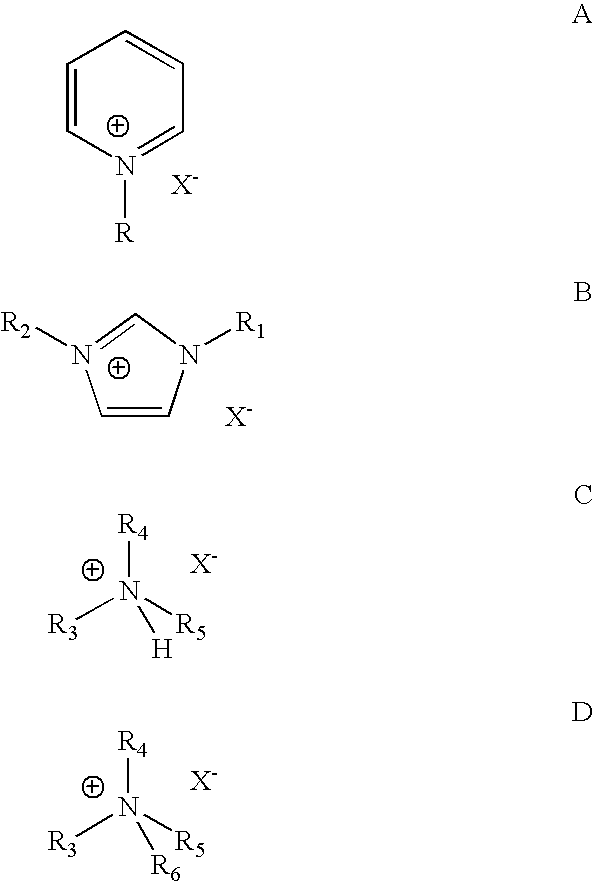Reduction of organic halide contamination in hydrocarbon products
a technology of organic halide and hydrocarbon products, which is applied in the direction of hydrocarbon preparation catalysts, hydrocarbon oil treatment products, separation processes, etc., can solve the problems of the need for safer and more environmentally friendly catalyst systems in the industries involved
- Summary
- Abstract
- Description
- Claims
- Application Information
AI Technical Summary
Benefits of technology
Problems solved by technology
Method used
Image
Examples
example 1
Chloride Reduction in Alkylate Hydrocarbon Using Various Adsorption Material
[0035]In a closed container, 0.5 g of absorption material and 50 mL of gasoline containing organic chloride were charged. The mixture was shaken vigorously to ensure uniform mixing for 30 minutes. Then the mixture is allowed to settle to separate the alkylate gasoline from the solid absorbent material. Gasoline samples before and after absorption were compared to determine effectiveness of absorption material. The results are summarized in Table 1.
[0036]
TABLE 1Comparison of Organic Chloride Uptake byZeolite vs. Amorphous MaterialCl (ppm) inCl (ppm) inClAbsorptionAs-AlkylatedGasoline, AfterReduction,MaterialGasolineAbsorption%CommentSilica-alumina1286101221.3Base caseUSY12863797.1InventionNaX88099+ Invention
The above results indicate that NaX and USY zeolites gave far better performance than amorphous silica-alumina. Our results clearly showed that micropore containing molecular sieve material is much preferr...
example 2
Chloride Absorption Capacity of Various Adsorption Material
[0037]Table 2 summarizes the absorption capacity of the different materials. In these examples, different amounts of the absorption material were added to 50 mL of gasoline containing alkyl chloride The chloride levels in the alkylate hydrocarbon gasoline and the alkylate hydrocarbon product were measured. Then the maximum uptake capacity of organic chloride per gram of absorbent material was calculated.
[0038]
TABLE 2Organic Chloride Uptake Capacity of Various MaterialsAbsorption Capacity,Absorption Materialg Cl / g absorbentCommentSilica-alumina0.01Base caseNaA0.06InventionNaX0.16InventionUSY0.07InventionCs exchanged USY0.05Invention
[0039]The above data indicate micropore containing zeolite materials have far superior absorption capacity for organic chloride that mesoporous silica-alumina material.
example 3
Continuous Organic Chloride Removal Process
[0040]A ⅜″ O.D. reactor tube was charged with a 12 cc of NaX molecular sieve sized to −24 / +40 diluted with 6 cc of 90 grit silicon carbide. The NaX was dried by heating to 600° F. for a minimum of 1 hour under a N2 flow. The reactor was then allowed to cool to room temperature (approximately 70° F.). Alkylate gasoline with a chloride level between 50 ppm and 900 ppm was then passed over the absorption material at room temperature at a linear hourly space velocity (LHSV) between 1 hr−1 and 10 hr−1. The reactor effluent was collected and analyzed by X-ray Fluorescence Spectrometry (XRF) to measure the chloride level. The alkylate gasoline was fed to the unit until breakthrough of organic chloride was observed, and absorption capacity was calculated.
[0041]During the absorption period, the NaX molecular sieve showed a chloride absorption capacity of 0.1 g chloride / g NaX. Analysis of the reactor effluent by gas chromatography showed no degradati...
PUM
| Property | Measurement | Unit |
|---|---|---|
| concentration | aaaaa | aaaaa |
| pore sizes | aaaaa | aaaaa |
| pressure | aaaaa | aaaaa |
Abstract
Description
Claims
Application Information
 Login to View More
Login to View More - R&D
- Intellectual Property
- Life Sciences
- Materials
- Tech Scout
- Unparalleled Data Quality
- Higher Quality Content
- 60% Fewer Hallucinations
Browse by: Latest US Patents, China's latest patents, Technical Efficacy Thesaurus, Application Domain, Technology Topic, Popular Technical Reports.
© 2025 PatSnap. All rights reserved.Legal|Privacy policy|Modern Slavery Act Transparency Statement|Sitemap|About US| Contact US: help@patsnap.com

